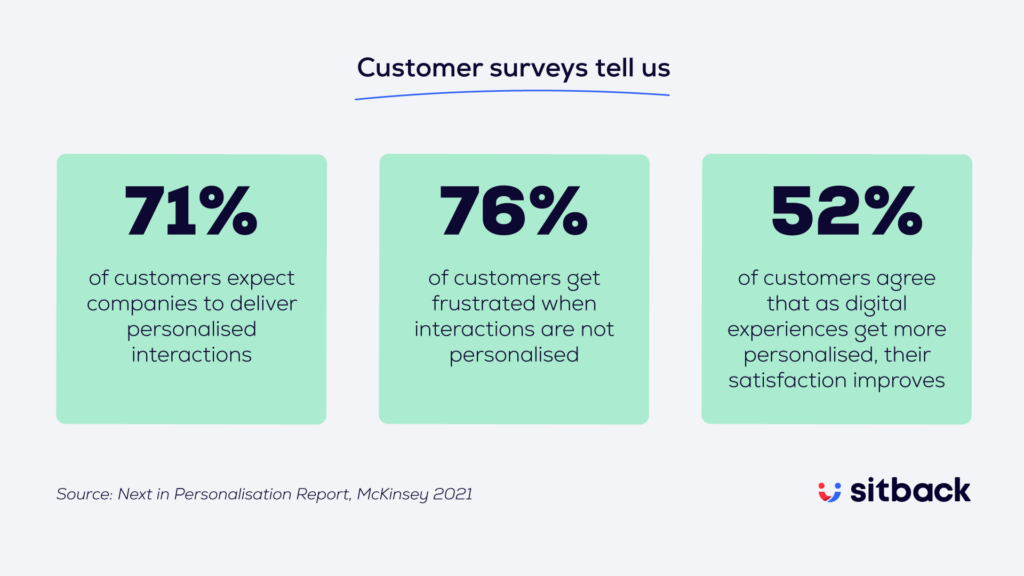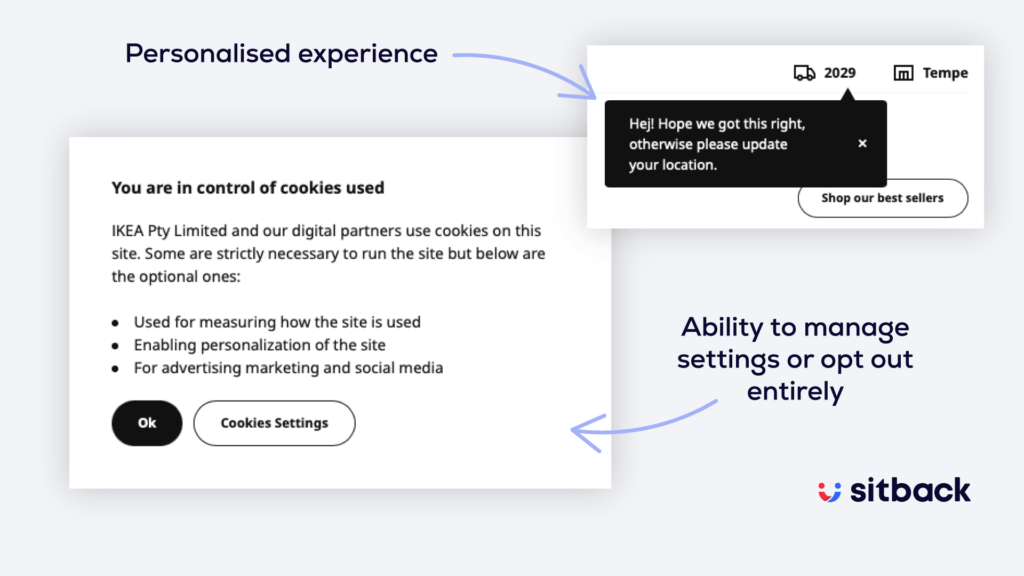An ethical look at website personalisation

It’s difficult to pinpoint a moment in time when website personalisation was conceived. Over the last two decades, website and content personalisation has developed from a desire to imitate the relationship you have with your local cafe or favourite store. From welcoming you back, to knowing your name, to memorising your order, delivering a personalised experience is considered critical, both online and IRL.
However, it has not been smooth sailing getting users to adopt, and ultimately welcome, personalisation. This is because personalisation requires the use of cookies to harvest and retain user data. When we first started to hear about personalisation, it took a little time for the implications of such data collection to sink in. Many were wary of the privacy implications – even those of us in the marketing space. Is it unethical to collect data from sometimes unknowing users? Nefarious, even?
As time went on and personalisation became more advanced, it crept into our online life more and more. And while at first we may have thought it was creepy, we quickly accepted it as the norm. After all, we love that our barista knows our name and our order. It’s no surprise that a website that knows our approximate location and can provide up to date stock levels for our closest store is appealing.
And so, personalisation continued to grow into a more refined and sophisticated tool.
A political bomb was dropped in 2014 when it was uncovered that “The data analytics firm that worked with Donald Trump’s election team and the winning Brexit campaign harvested millions of Facebook profiles of US voters…and used them to build a powerful software program to predict and influence choices at the ballot box.” This served to reinforce public concern over their personal privacy, and most certainly not only stymied the growth of personalised experiences, but once again awoke the data privacy ethics beast.
What do the statistics really show?
Let’s fast forward to 2023 and take a closer look at what the statistics show that people really think about personalisation.

A large majority of customers surveyed say that non-personalised experiences feel lacking and immature, now that we’re so used to them. The consumer expects personalised interactions, even in the banking industry where security is paramount. Forbes research explains that a whopping “72% of consumers said they would be happy for their banks to use web behavioural data…to secure their banking experience”.
How do we ethically collect data in a way that is respectful and productive?
Much has been done to allay fears over personal data falling into the wrong hands. But to continue to build trust and respect, it’s imperative that we employ best practices in several different ways.
Build trust
In an environment where people have the opportunity to find information, buy products, or request services (including not from you!) in a split second, never underestimate the value of building trust and reputation.
Forbes, cited earlier, also said that with the mass of banking interactions now happening on mobile devices, the type of data that can be harvested is more personal. For example, factors such as whether the user is right or left handed, what time they typically wake up or leave for work, or even what times they frequently use the bathroom, could be analysed. This illustrates how important it is for building trust to only use data that can enrich the user experience – and leave out anything that could be perceived as crossing a line.
The “Authority Bias” is a cognitive bias that shows humans in general have a strong tendency to comply with those in charge – brands with badges, awards and customer rankings play a strong role in appealing to the authority bias. In combination with that finding, people are usually looking for information that supports their beliefs, ignoring what doesn’t. This is a cognitive bias called confirmation bias, and both of these biases can be used for the good of your customer when you’ve harnessed the right information about them.
Let’s say your company produces baby formula. You have learned through your personalised online surveys that second to nutritional value, your customers care deeply about their formula being Australian made. If your formula is produced using Australian cows milk, you could easily market it as being “Australian made”. However, this is where the ethical side of personalisation comes into play – because in fact while it’s true your formula is produced using Australian milk, the milk is shipped offshore for processing before landing back on Australian shelves with its beautiful branding images of Bega cows nestled on rolling hills.
In an industry such as baby formula, you can be absolutely certain that the majority of parents will do their research. Your brand will suffer greatly when they realise that the information they willingly provided to you in an effort to help you improve their experience was exploited.
Whether it’s banking and finance, food, sporting goods, or anything in between – trust is king in marketing.
Opt outs and opt ins
Make sure that your customer can opt out of marketing material at any time. The majority of CMS, CRM, and email marketing software either have direct, or integrated ways of providing customers with a way to opt out of communications from you. The law states the onus is on you to inform your customer that 1. By providing their information and ticking the ‘I agree’ box, they are opting in. And 2. They have the opportunity at every email communication point to opt out in an unconvoluted way. In fact, the anti-spam law states that it is your responsibility to “make it easy to unsubscribe”.
You won’t be surprised to know that cognitive bias has a part to play in opt outs as well. While making an opt out reasonably obvious is essential, the line is grey on how obvious. It would be easy to appeal to the isolation effect bias (highlighting some point of difference that stands out to customers, guiding them to the ‘opt in’ option) but be cautious not to overdo it. Highlighting the opt-ins in a way that overpowers the opt out is common, but we should be aiming to continue building trust.
Accept cookies
All websites use cookies. Cookies are important because they allow a streamlined customer experience, such as knowing what to suggest for us to browse next based on our browsing history, or remembering that we’ve already logged in to a site even if it’s on another tab.
Cookie privacy legislation requires websites to get consent from visitors to store or retrieve any non-essential information passively acquired from a user. This is usually managed by third-party modules that flag to developers where the content management system is collecting data that needs to be consented to. Users need to be able to opt out of having their data tracked if they want to. The reality is, most users recognise the benefit of having their data stored, as it makes for a better online experience in the majority of cases. But for the small percentage of people who would prefer to opt out, a nice workaround solution is to offer to opt the user out of a selection of cookies, like this example at IKEA.com.au:

The basics
We think we’ve sold you on it: to ensure the utmost respect is provided to your users, we have to follow the law, and even further – make it best practice. They don’t have to give out their personal information, so the last thing we want is to seem to be collecting data in ways that are not mutually beneficial. When we respect our users’ privacy, the follow on effect is that it builds trust in your brand and reputation, it encourages more conversions, and it shows you care about your customer. When it comes to personalisation, lead the way in your industry with best practice!
For more information on website personalisation, check out the other articles in our series:
- Overcoming personalisation paralysis: Start small, learn fast (on-demand webinar)
- Simplifying website personalisation in a competitive market
- 4 compelling reasons to personalise your website (even if you’re not in e-commerce)
- An ethical look at website personalisation (this post)
And if you want to kick-start your personalisation journey, take it to the next level, or explore how human psychology can be leveraged to improve your customer journeys, get in touch through the form below – we ❤️ to talk about this stuff!